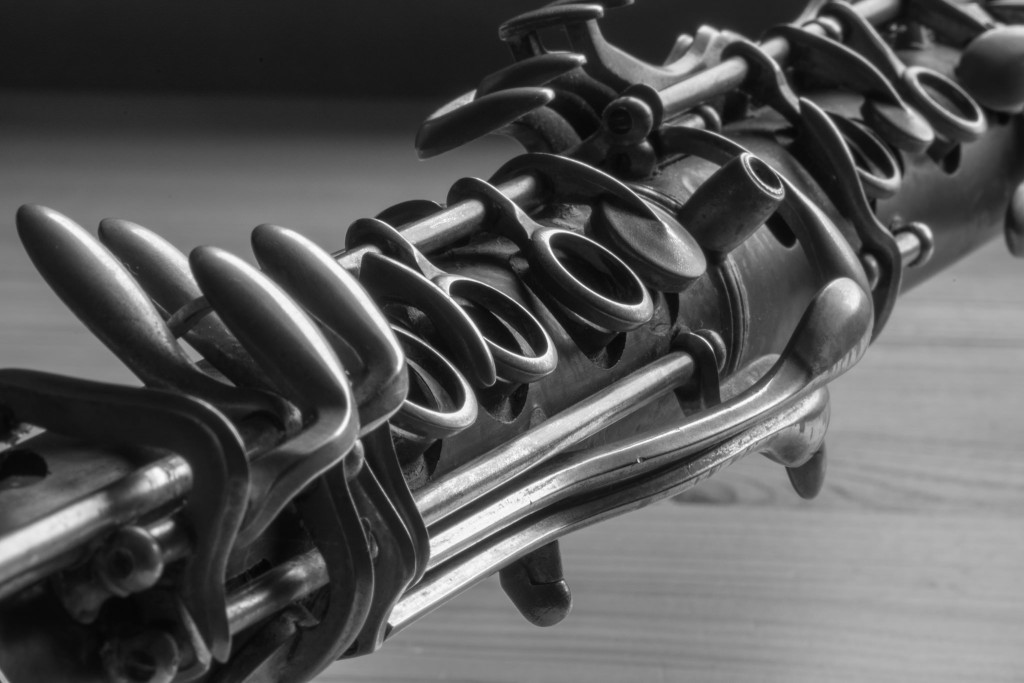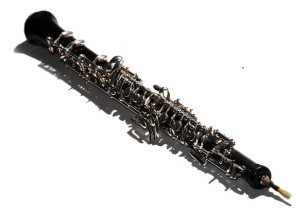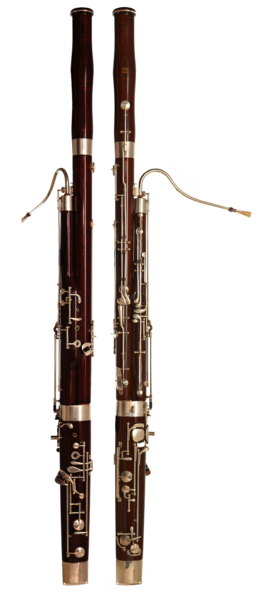6.4: Woodwinds
- Page ID
- 72388
\( \newcommand{\vecs}[1]{\overset { \scriptstyle \rightharpoonup} {\mathbf{#1}} } \)
\( \newcommand{\vecd}[1]{\overset{-\!-\!\rightharpoonup}{\vphantom{a}\smash {#1}}} \)
\( \newcommand{\dsum}{\displaystyle\sum\limits} \)
\( \newcommand{\dint}{\displaystyle\int\limits} \)
\( \newcommand{\dlim}{\displaystyle\lim\limits} \)
\( \newcommand{\id}{\mathrm{id}}\) \( \newcommand{\Span}{\mathrm{span}}\)
( \newcommand{\kernel}{\mathrm{null}\,}\) \( \newcommand{\range}{\mathrm{range}\,}\)
\( \newcommand{\RealPart}{\mathrm{Re}}\) \( \newcommand{\ImaginaryPart}{\mathrm{Im}}\)
\( \newcommand{\Argument}{\mathrm{Arg}}\) \( \newcommand{\norm}[1]{\| #1 \|}\)
\( \newcommand{\inner}[2]{\langle #1, #2 \rangle}\)
\( \newcommand{\Span}{\mathrm{span}}\)
\( \newcommand{\id}{\mathrm{id}}\)
\( \newcommand{\Span}{\mathrm{span}}\)
\( \newcommand{\kernel}{\mathrm{null}\,}\)
\( \newcommand{\range}{\mathrm{range}\,}\)
\( \newcommand{\RealPart}{\mathrm{Re}}\)
\( \newcommand{\ImaginaryPart}{\mathrm{Im}}\)
\( \newcommand{\Argument}{\mathrm{Arg}}\)
\( \newcommand{\norm}[1]{\| #1 \|}\)
\( \newcommand{\inner}[2]{\langle #1, #2 \rangle}\)
\( \newcommand{\Span}{\mathrm{span}}\) \( \newcommand{\AA}{\unicode[.8,0]{x212B}}\)
\( \newcommand{\vectorA}[1]{\vec{#1}} % arrow\)
\( \newcommand{\vectorAt}[1]{\vec{\text{#1}}} % arrow\)
\( \newcommand{\vectorB}[1]{\overset { \scriptstyle \rightharpoonup} {\mathbf{#1}} } \)
\( \newcommand{\vectorC}[1]{\textbf{#1}} \)
\( \newcommand{\vectorD}[1]{\overrightarrow{#1}} \)
\( \newcommand{\vectorDt}[1]{\overrightarrow{\text{#1}}} \)
\( \newcommand{\vectE}[1]{\overset{-\!-\!\rightharpoonup}{\vphantom{a}\smash{\mathbf {#1}}}} \)
\( \newcommand{\vecs}[1]{\overset { \scriptstyle \rightharpoonup} {\mathbf{#1}} } \)
\( \newcommand{\vecd}[1]{\overset{-\!-\!\rightharpoonup}{\vphantom{a}\smash {#1}}} \)
\(\newcommand{\avec}{\mathbf a}\) \(\newcommand{\bvec}{\mathbf b}\) \(\newcommand{\cvec}{\mathbf c}\) \(\newcommand{\dvec}{\mathbf d}\) \(\newcommand{\dtil}{\widetilde{\mathbf d}}\) \(\newcommand{\evec}{\mathbf e}\) \(\newcommand{\fvec}{\mathbf f}\) \(\newcommand{\nvec}{\mathbf n}\) \(\newcommand{\pvec}{\mathbf p}\) \(\newcommand{\qvec}{\mathbf q}\) \(\newcommand{\svec}{\mathbf s}\) \(\newcommand{\tvec}{\mathbf t}\) \(\newcommand{\uvec}{\mathbf u}\) \(\newcommand{\vvec}{\mathbf v}\) \(\newcommand{\wvec}{\mathbf w}\) \(\newcommand{\xvec}{\mathbf x}\) \(\newcommand{\yvec}{\mathbf y}\) \(\newcommand{\zvec}{\mathbf z}\) \(\newcommand{\rvec}{\mathbf r}\) \(\newcommand{\mvec}{\mathbf m}\) \(\newcommand{\zerovec}{\mathbf 0}\) \(\newcommand{\onevec}{\mathbf 1}\) \(\newcommand{\real}{\mathbb R}\) \(\newcommand{\twovec}[2]{\left[\begin{array}{r}#1 \\ #2 \end{array}\right]}\) \(\newcommand{\ctwovec}[2]{\left[\begin{array}{c}#1 \\ #2 \end{array}\right]}\) \(\newcommand{\threevec}[3]{\left[\begin{array}{r}#1 \\ #2 \\ #3 \end{array}\right]}\) \(\newcommand{\cthreevec}[3]{\left[\begin{array}{c}#1 \\ #2 \\ #3 \end{array}\right]}\) \(\newcommand{\fourvec}[4]{\left[\begin{array}{r}#1 \\ #2 \\ #3 \\ #4 \end{array}\right]}\) \(\newcommand{\cfourvec}[4]{\left[\begin{array}{c}#1 \\ #2 \\ #3 \\ #4 \end{array}\right]}\) \(\newcommand{\fivevec}[5]{\left[\begin{array}{r}#1 \\ #2 \\ #3 \\ #4 \\ #5 \\ \end{array}\right]}\) \(\newcommand{\cfivevec}[5]{\left[\begin{array}{c}#1 \\ #2 \\ #3 \\ #4 \\ #5 \\ \end{array}\right]}\) \(\newcommand{\mattwo}[4]{\left[\begin{array}{rr}#1 \amp #2 \\ #3 \amp #4 \\ \end{array}\right]}\) \(\newcommand{\laspan}[1]{\text{Span}\{#1\}}\) \(\newcommand{\bcal}{\cal B}\) \(\newcommand{\ccal}{\cal C}\) \(\newcommand{\scal}{\cal S}\) \(\newcommand{\wcal}{\cal W}\) \(\newcommand{\ecal}{\cal E}\) \(\newcommand{\coords}[2]{\left\{#1\right\}_{#2}}\) \(\newcommand{\gray}[1]{\color{gray}{#1}}\) \(\newcommand{\lgray}[1]{\color{lightgray}{#1}}\) \(\newcommand{\rank}{\operatorname{rank}}\) \(\newcommand{\row}{\text{Row}}\) \(\newcommand{\col}{\text{Col}}\) \(\renewcommand{\row}{\text{Row}}\) \(\newcommand{\nul}{\text{Nul}}\) \(\newcommand{\var}{\text{Var}}\) \(\newcommand{\corr}{\text{corr}}\) \(\newcommand{\len}[1]{\left|#1\right|}\) \(\newcommand{\bbar}{\overline{\bvec}}\) \(\newcommand{\bhat}{\widehat{\bvec}}\) \(\newcommand{\bperp}{\bvec^\perp}\) \(\newcommand{\xhat}{\widehat{\xvec}}\) \(\newcommand{\vhat}{\widehat{\vvec}}\) \(\newcommand{\uhat}{\widehat{\uvec}}\) \(\newcommand{\what}{\widehat{\wvec}}\) \(\newcommand{\Sighat}{\widehat{\Sigma}}\) \(\newcommand{\lt}{<}\) \(\newcommand{\gt}{>}\) \(\newcommand{\amp}{&}\) \(\definecolor{fillinmathshade}{gray}{0.9}\)Introduction
Woodwind instruments are a family of musical instruments within the more general category of wind instruments. There are two main types of woodwind instruments: flutes and reed instruments (otherwise called reed pipes). What differentiates these instruments from other wind instruments is the way in which they produce their sound.

Modern Orchestra and Concert Band Woodwinds
The modern orchestra’s woodwind section typically includes: flutes, oboes, clarinets, and bassoons. The piccolo, cor anglais, bass clarinet, and contrabassoon are commonly used supplementary woodwind instruments. The section may also on occasion be expanded by the addition of saxophone(s).
The concert band’s woodwind section is typically much larger and more diverse than the orchestra’s. The concert band’s woodwind section typically includes: piccolo, flutes, oboes, B♭ clarinets, bass clarinets, bassoons, alto saxophones, tenor saxophone, and baritone saxophone. The cor anglais, E♭ clarinet, alto clarinet, contra-alto clarinet, contrabass clarinet, contrabassoon, and soprano saxophone are also used, but not as frequently as the other woodwinds.
Flutes produce sound by directing a focused stream of air across the edge of a hole in a cylindrical tube. The flute family can be divided into two sub-families: open flutes, and closed flutes.
To produce a sound with open flutes, the player is required to blow a stream of air across a sharp edge that then splits the airstream . This split airstream then acts upon the air column contained within the flute’s hollow causing it to vibrate and produce sound. Examples of open flutes are the transverse flute, panpipes and ocarinas. Ancient flutes of this variety were often made from tubular sections of plants such as grasses, reeds, and hollowed-out tree branches. Later, flutes were made of metals such as tin, copper, or bronze. Modern concert flutes are usually made of high-grade metal alloys, usually containing nickel, silver, copper, or gold.
To produce a sound with a closed flute, the player is required to blow air into a duct. This duct acts as a channel, bringing the air to a sharp edge. As with the open flutes, the air is then split; this causes the column of air within the closed flute to vibrate and produce sound. Examples of this type of flute include the recorder (instrument), and organ pipes.
Flute

Listen to a duo for flute and piano.
Flutes dating back to 43,000 to 35,000 years ago have been found in Germany, but the contemporary mechanism for contemporary flutes was developed between 1832 and 1847.
Oboe

Listen to an oboe concerto.
Oboes first appeared in the mid-seventeenth century and were developed further in the nineteenth century.
English Horn

Listen to the English horn.
The English horn originated in about 1720.
Clarinet

Listen to the clarinet.
The clarinet became a standard orchestral instrument by the 1800s.
Bassoon

Listen to the bassoon.
The bassoon was developed in the first half of the nineteenth century.
Contrabassoon

Listen to the contrabassoon.
The contrabassoon was developed in the mid-eighteenth century.
Contributors and Attributions
- Woodwind instrument. Provided by: Wikipedia. Located at: https://en.Wikipedia.org/wiki/Woodwind_instrument. License: CC BY-SA: Attribution-ShareAlike
- Flute. Provided by: Wikipedia. Located at: http://commons.wikimedia.org/wiki/File:Flute.jpg. License: CC0: No Rights Reserved
- English Horn picture. Authored by: Hustvedt. Provided by: Wikipedia. Located at: https://commons.wikimedia.org/wiki/File:English_Horn_picture.jpg. License: CC BY-SA: Attribution-ShareAlike
- Clarinet. Authored by: Iunity. Provided by: Wikipedia. Located at: https://commons.wikimedia.org/wiki/File:Clarinet.png. License: CC0: No Rights Reserved
- FoxBassoon. Authored by: Gregory F. Maxwell. Provided by: Wikipedia. Located at: https://commons.wikimedia.org/wiki/File:FoxBassoon.png. License: Other. License Terms: GNU Free Documentation License, Version 1.2
- Contrabassoon2 flipped. Authored by: Mezzofortist; Smurfett. Provided by: Wikipedia. Located at: https://commons.wikimedia.org/wiki/File:Contrabassoon2_flipped.png. License: CC BY-SA: Attribution-ShareAlike
- Clarinet. Authored by: Peter Miller. Located at: https://www.flickr.com/photos/pmillera4/16251498490/. License: CC BY-NC-ND: Attribution-NonCommercial-NoDerivatives
- Mozart - Concerto for Flute and Orchestra G-dur K 313 (285C) Emmanuel Pahud.. Authored by: Andrey Kostyagin. Located at: https://youtu.be/8zPkWVqdJXI?t=52s. License: All Rights Reserved. License Terms: Standard YouTube License
- Mozart Oboe Concerto (Allegro Aperto) - Nicholas Daniel / Bu011blohlu00e1vek / BBC Symphony. Authored by: Nicholas Daniel. Located at: https://youtu.be/DhygJyCvYeA?t=59s. License: All Rights Reserved. License Terms: Standard YouTube License
- Mozart Adagio K580a - English horn Giuliano Giuliani. Authored by: Guido Gualandi. Located at: https://youtu.be/ePFIlpBJq1o?t=1s. License: All Rights Reserved. License Terms: Standard YouTube License
- Bernstein performs Gershwin Rhapsody in Blue 1/2. Authored by: Felipe Ruiz de Chu00e1vez. Located at: https://youtu.be/xxb7yNG0DGc?t=15s. License: All Rights Reserved. License Terms: Standard YouTube License
- Mozart: Bassoon Concerto in B-flat major KV191, 1st movement (Allegro). Authored by: bububasso. Located at: https://www.youtube.com/watch?v=ARkz1oCtncM&feature=youtu.be&t=57s. License: All Rights Reserved. License Terms: Standard YouTube License
- Variations on a Theme of Robert Schumann for Contrabassoon (The Happy Farmer). Authored by: timbauernfeind. Located at: https://youtu.be/KIJrMb7mOVI?t=1s. License: All Rights Reserved. License Terms: Standard YouTube License


